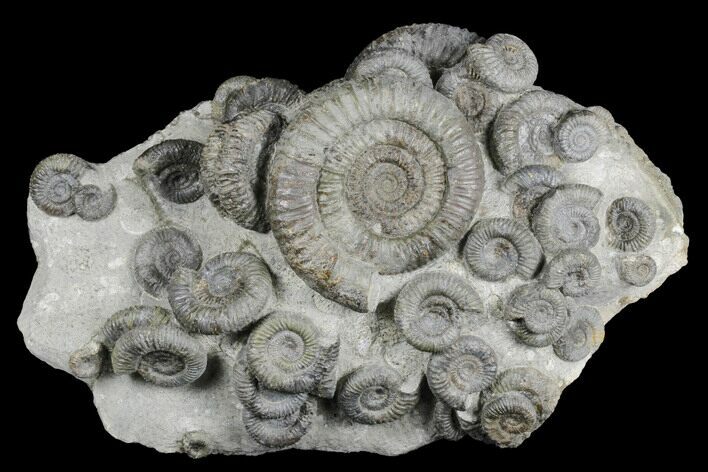This Specimen has been sold.
8.2" Fossil Ammonite (Dactylioceras) Cluster - Sandsend, England
This is an impressive, 8.2" wide cluster of Dactylioceras ammonites from the Sandsend, England. You don't typically get these ammonites in dense clusters like this. Countless hours of preparation work went into exposing the individual ammonites from the hard rock with mechanical tools.
There are over 30 ammonites present of both Dactylioceras toxophorum and Dactylioceras gracile. Most of the ammonites are around 1" wide, but the largest is 2.8"
This piece comes out of the collection of the late Jeff Mulroy, a renown collector and preparitor of Yorkshire fossils.
Comes with a display stand.
There are over 30 ammonites present of both Dactylioceras toxophorum and Dactylioceras gracile. Most of the ammonites are around 1" wide, but the largest is 2.8"
This piece comes out of the collection of the late Jeff Mulroy, a renown collector and preparitor of Yorkshire fossils.
Comes with a display stand.
About Ammonites
Ammonites were ancient marine cephalopods, similar to today's squids and octopuses, but with a defining feature: their distinctive, tightly coiled spiral shells. These shells, resembling those of modern nautiluses, served as both a protective home and a buoyancy aid, allowing ammonites to navigate the prehistoric seas with ease. First emerging around 240 million years ago in the Triassic Period, ammonites thrived for over 175 million years, adapting through numerous forms and sizes. As predatory creatures, they likely fed on smaller marine organisms, using their tentacles to capture prey. However, their long reign came to an end 65 million years ago at the close of the Cretaceous, coinciding with the mass extinction event that also eliminated the dinosaurs.
Ammonites were ancient marine cephalopods, similar to today's squids and octopuses, but with a defining feature: their distinctive, tightly coiled spiral shells. These shells, resembling those of modern nautiluses, served as both a protective home and a buoyancy aid, allowing ammonites to navigate the prehistoric seas with ease. First emerging around 240 million years ago in the Triassic Period, ammonites thrived for over 175 million years, adapting through numerous forms and sizes. As predatory creatures, they likely fed on smaller marine organisms, using their tentacles to capture prey. However, their long reign came to an end 65 million years ago at the close of the Cretaceous, coinciding with the mass extinction event that also eliminated the dinosaurs.
SPECIES
Dactylioceras toxophorum & Dactylioceras gracile
LOCATION
Sandsend, Whitby, North Yorkshire, England
SIZE
Cluster 8.2 x 5.5 x 2.6", Largest ammonite 2.8"
CATEGORY
SUB CATEGORY
ITEM
#176299
We guarantee the authenticity of all of our specimens.
 Reviews
Reviews

















